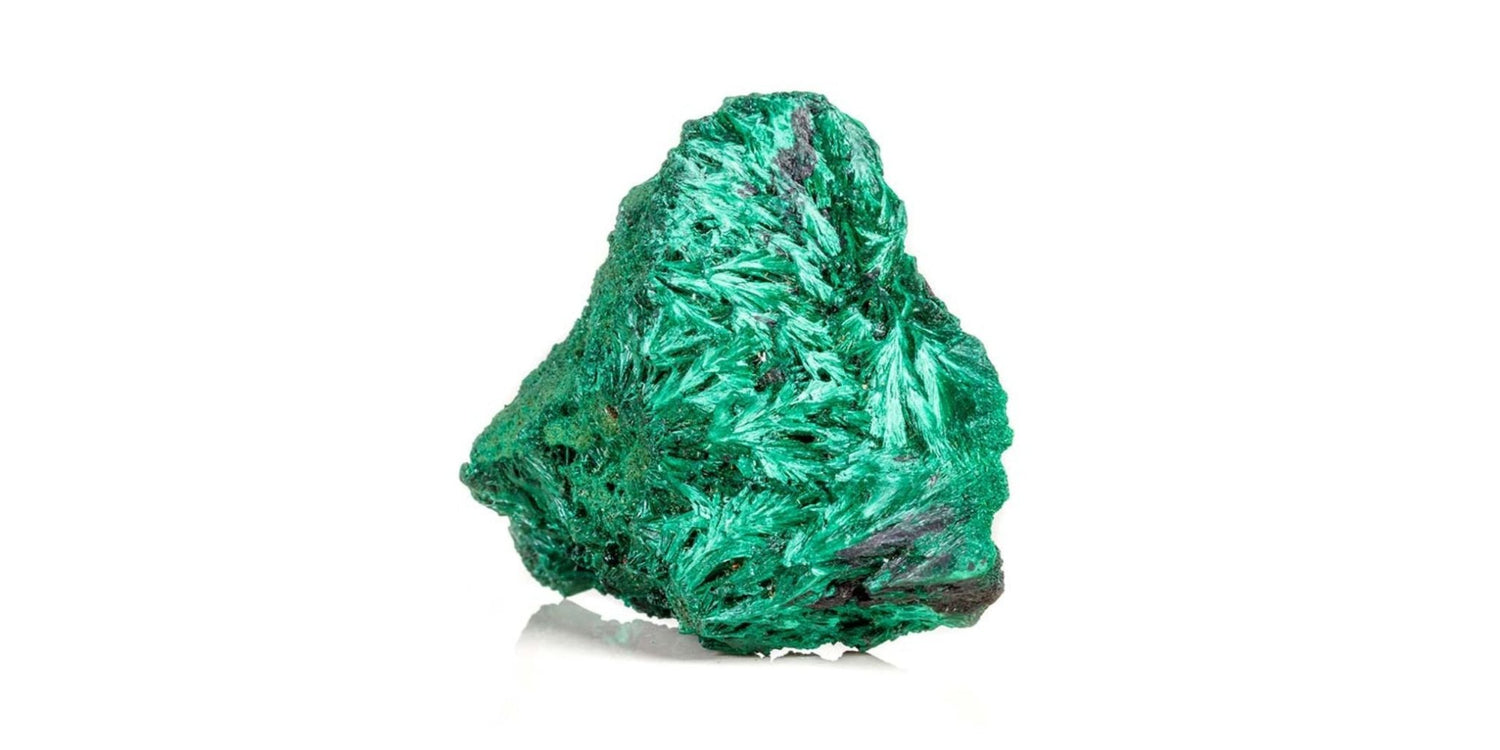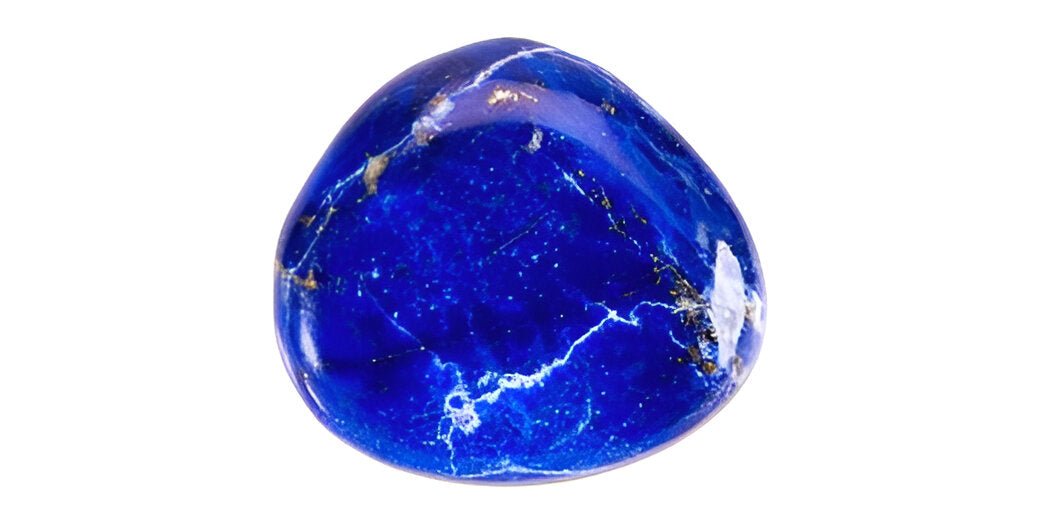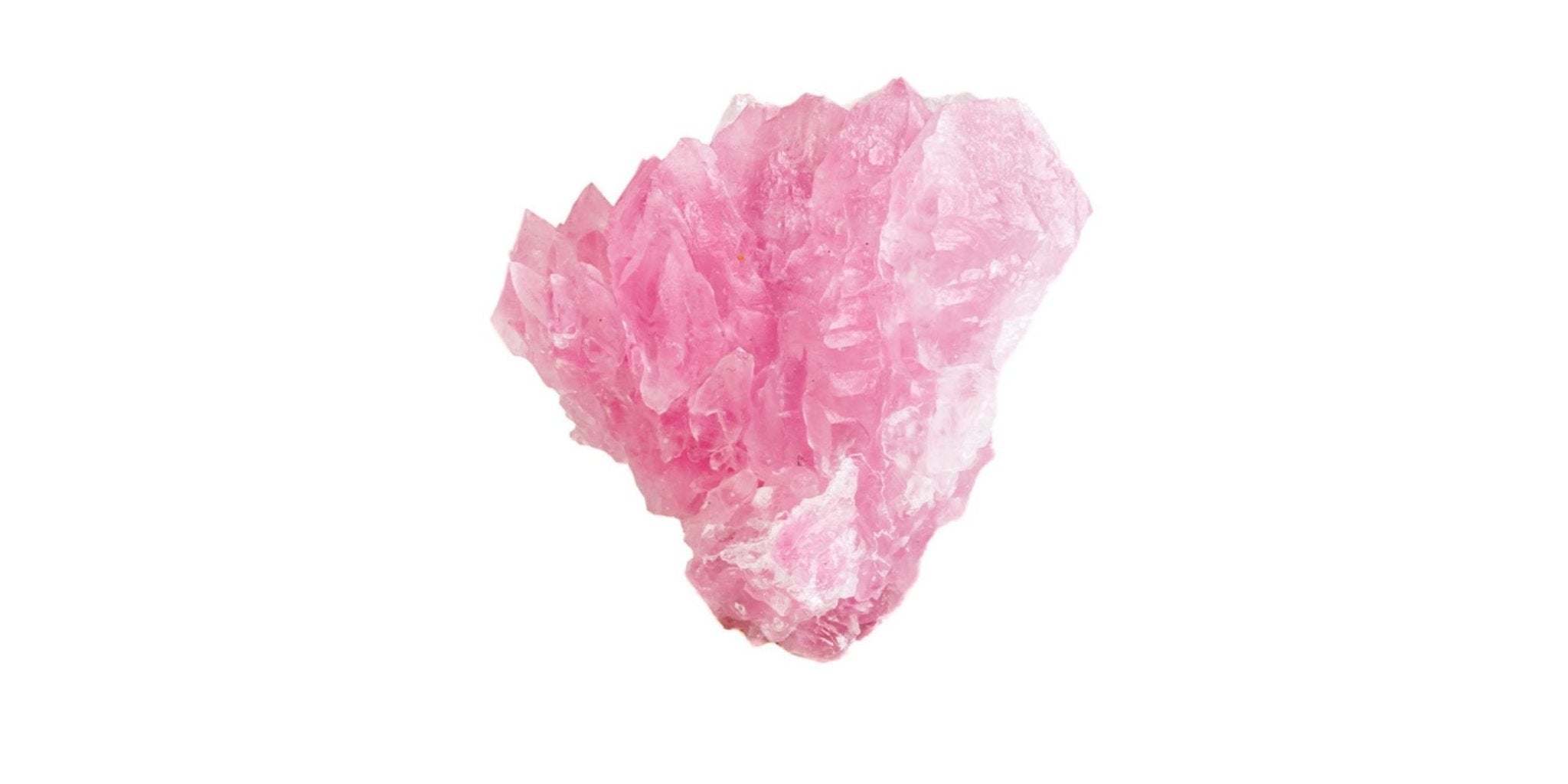Malachite Stone Profile
- Origin of the name: The name "Malachite" comes from the Ancient Greek "malakos," meaning "soft," in reference to the stone's low hardness and its green color similar to mallow leaves.
- Group: Malachite belongs to the carbonate group.
- Chemical Composition: Malachite is composed of Cu₂CO₃(OH)₂, which is hydrated copper carbonate.
- Crystal System: Malachite crystallizes in the monoclinic system.
- Hardness: Malachite has a hardness of 3.5 to 4 on the Mohs scale.
- Deposits: Malachite is found in several countries, including the Democratic Republic of the Congo, Russia, Australia, the United States, Namibia, Zambia, and Morocco.
- Color(s): Malachite displays colors ranging from light to dark green, often with bands or marbling in black or lighter shades.
- Chakras: Malachite is associated with the heart chakra, also known as Anahata.
Where does the name Malachite come from?
The name "Malachite" has its roots in ancient history and linguistics, particularly in Greek and Latin cultures. Its etymology reveals connections to the physical properties and uses of the stone throughout the ages. To fully understand the origin of the name "Malachite," it is essential to explore its etymology, history, and distinctive features.
Etymological Origin
The term "Malachite" comes from the Ancient Greek "malakos" (μαλακός), meaning "soft" or "supple." This name refers to the relative softness of the stone compared to other minerals. In fact, malachite has a hardness of 3.5 to 4 on the Mohs scale, making it easier to work and carve. The visual appearance of malachite, with its green shades and banded patterns, also evokes the color of mallow leaves (malakhe in Greek), a widely known and common plant in Antiquity.
History and Use
Malachite has a long history of use dating back several millennia. The Ancient Egyptians mined malachite in the Sinai Peninsula and used it for jewelry, amulets, and ornaments. It was also ground to create green pigments used in art and cosmetics. The Greek name likely influenced the nomenclature adopted by the Romans, who helped spread malachite throughout the Empire.
Distinctive Features
Malachite is distinguished by its intense green color and its banded patterns, which range from light to dark green. These patterns are caused by variations in copper concentration within the stone. Malachite is a hydrated copper carbonate, with the chemical formula Cu₂CO₃(OH)₂. Its unique green color and optical properties have captivated humanity since Antiquity.
Influence and Legacy
The name "Malachite" reflects not only the physical properties of the stone but also its cultural and historical role. The transition of the name through Greek and Latin into modern languages illustrates how the stone has been valued and used by different civilizations. Today, malachite is still appreciated for its beauty and energetic properties in the field of crystal healing.
What is the history of the Malachite stone?
Ancient Origins
Malachite has been mined and used since antiquity. The earliest traces of its use date back to around 4000 BC in Egypt and Mesopotamia. Egyptians extracted malachite from mines in the Sinai Peninsula. They ground it to make green pigments used in frescoes and cosmetics, notably as eye shadow.
Symbolism and Beliefs
Ancient civilizations attributed magical and healing properties to malachite. In Egypt, it was associated with the goddess Hathor, goddess of love, beauty, and protection. Egyptians believed that malachite could protect against illness and danger. Malachite amulets were often placed in tombs to ensure protection in the afterlife.
In Greece and Rome, malachite was also highly valued. The Greeks called it "malachites" in reference to the mallow plant, whose leaves share a similar color. The Romans used malachite in the making of jewelry, sculptures, and various decorative objects. They believed the stone could ward off evil spirits and bring luck and health.
Use in the Middle Ages and the Renaissance
During the Middle Ages, malachite continued to be used for its protective virtues. It was believed to protect children from nightmares and evil spirits. Knights sometimes carried it as a talisman during the Crusades.
During the Renaissance, interest in malachite intensified. European artists used malachite pigments to create paintings and frescoes. Its intense green color was especially valued for depictions of landscapes and vegetation.
Mining and Discovery of New Deposits
With the advent of the industrial era, new malachite deposits were discovered in Russia, particularly in the Ural mines. The malachite from this region, renowned for its magnificent hues and large blocks, became highly sought after. The Russian tsars used malachite to adorn their palaces, creating columns, fireplaces, and sumptuous decorative objects.
Malachite in Modern Times
Today, malachite is mainly mined in the Democratic Republic of the Congo, Zambia, Russia, and a few other countries. It is used in jewelry, sculpture, and the creation of various art objects. Its natural beauty and unique patterns continue to captivate mineral enthusiasts.
What is the origin and composition of Malachite stone?
Malachite, renowned for its green color and banded patterns, is a stone that has fascinated people for millennia. To fully understand this stone, it is essential to explore its geological origins and chemical composition.
Geological Origin of Malachite
Malachite is a secondary mineral that forms in the oxidation zones of copper deposits. It results from the chemical reaction between solutions containing copper and carbonate or hydroxide. This process generally occurs in arid environments where water is able to transport copper ions over long distances.
The main malachite deposits are found in regions where copper is abundant. Among the most famous locations are the Democratic Republic of the Congo, which produces some of the world's finest malachite, as well as Russia, particularly in the Ural Mountains, and Zambia. Malachite can also be found in the United States, Australia, Namibia, and Morocco.
The formation of malachite is often associated with other copper minerals, such as azurite, with which it frequently coexists. This association sometimes gives rise to combined stone specimens called "azurite-malachite," featuring striking blue and green patterns.
Physical Properties
In addition to its chemical composition, malachite has several distinctive physical properties. It crystallizes in the monoclinic system, forming prismatic or acicular crystals. However, it is most often found as botryoidal, fibrous, or stalactitic masses, which display the famous green concentric banded patterns.
Malachite's hardness on the Mohs scale is 3.5 to 4, making it relatively soft and easy to carve. Its density ranges from 3.6 to 4 g/cm³, and it has a silky to vitreous luster when polished.
Uses and Historical Significance
Historically, malachite was used to create green pigments due to its intense color. The ancient Egyptians, Greeks, and Romans used this pigment in frescoes and paintings. Today, malachite is mainly used in jewelry and crystal healing, valued for its beauty and its reputed healing properties.
What are the benefits of Malachite (physical and psychological)?
Malachite is a precious stone valued not only for its beauty but also for its many physical and psychological benefits. Used since antiquity, it is renowned for its healing and protective properties. Let us explore in detail the benefits attributed to this fascinating stone.
Physical Benefits of Malachite
Malachite is widely recognized for its physical benefits. Here are some of its most notable properties:
1. Anti-inflammatory and Analgesic Properties: Malachite is often used to relieve pain and inflammation. It is said to be effective for joint and muscle pain, cramps, and even headaches. It can be applied directly to painful areas or worn as jewelry for a general effect.
2. Immune System Support: Malachite is believed to stimulate the immune system, helping the body fight infections and illnesses. It is sometimes used as a complement to traditional medical treatments to enhance healing.
3. Detoxification: The stone is also known for its detoxifying properties. It helps eliminate toxins from the body and purify the liver. Lithotherapy practitioners often recommend using it to support internal organ functions.
4. Improved Blood Circulation: Malachite is known for promoting healthy blood circulation. It may help regulate blood pressure and improve tissue oxygenation.
5. Skin Health: The ancient Egyptians already used malachite for its benefits on the skin. It is believed to help heal skin conditions such as rashes, wounds, and infections.
Psychological and Emotional Benefits of Malachite
On a psychological and emotional level, malachite is just as valuable. Here is how it can help improve mental health and emotional well-being:
1. Stone of Transformation: Malachite is often called the "stone of transformation." It helps overcome fears and resistance to change, making life transitions easier. It encourages decision-making and helps eliminate self-destructive behaviors.
2. Emotional Protection: Malachite is renowned for its protective properties. It absorbs negative energies and pollutants, helping to shield the aura and maintain a healthy emotional environment. Individuals sensitive to external energies often find comfort in wearing this stone.
3. Boosting Self-Confidence: By stimulating the heart chakra, malachite encourages emotional openness and self-confidence. It helps release emotional blockages and encourages the expression of true feelings.
4. Reducing Stress and Anxiety: Malachite is also known for its calming effects. It helps reduce stress and anxiety, bringing a sense of calm and tranquility. It is often used in meditation to promote inner peace.
5. Enhancing Intuition: Finally, malachite is believed to stimulate intuition and insight. It helps to better understand situations and make informed decisions. People seeking to develop their psychic abilities often find malachite very beneficial.
Using Malachite
To benefit from the properties of malachite, it is common to wear it as jewelry, use it during meditation, or place it in living or work spaces. However, it is important to note that raw malachite can be toxic if ingested or inhaled as dust, so it is recommended to handle the stone with care.
How to care for your Malachite stone jewelry?
Malachite, with its deep green hues and unique patterns, is a precious stone valued for its beauty and properties. However, due to its chemical composition and relative softness, it requires special care to preserve its shine and qualities. Here are some tips to care for your malachite jewelry and keep it in perfect condition.
Cleaning Malachite Jewelry
1. Gentle Cleaning: Malachite is a stone sensitive to chemicals and abrasion. To clean it, simply use a slightly damp soft cloth. Avoid harsh cleaning products, acidic solutions, and hard brushes that could scratch or damage the surface of the stone.
2. Use of Water: While malachite can be rinsed with water, avoid soaking it. Prolonged exposure to water can weaken the stone. If you need to rinse malachite, be sure to dry it immediately with a soft cloth to prevent water from seeping into the stone's internal structure.
Protection Against Chemicals
1. Avoid Beauty Products: Beauty products such as perfumes, hair sprays, and lotions may contain chemicals that can damage malachite. Apply these products before putting on your jewelry and make sure they are completely dry before wearing your malachite jewelry.
2. Household Products: When doing household chores, remove your malachite jewelry. Cleaning products, even those considered gentle, may contain chemicals that could react with malachite.
Proper Storage
1. Separate Storage: To avoid scratches and impacts, store your malachite jewelry separately from other pieces. Use soft fabric pouches or individual compartments in a jewelry box.
2. Avoid Sun Exposure: Prolonged exposure to direct sunlight can cause malachite to fade. Store your jewelry in a dark, dry place to preserve its color.
Recharging and Purification
1. Purification: Malachite can accumulate negative energies. To purify it, use white sage smudging or place it on a cluster of quartz for a few hours.
2. Recharging: Recharging malachite by exposing it to moonlight overnight can help revitalize its energies. Avoid exposing it to direct sunlight, which may alter its color.
Discover Our Malachite Bracelet Collection
Caring for your malachite jewelry ensures that it remains beautiful and full of energy for many years. Whether you are looking for a new piece to enrich your collection or a special gift, our malachite bracelet collections are designed to suit your tastes and needs.
For Women :
Explore our women's malachite stone bracelet collection, where each piece is carefully selected for its quality and unique design. These bracelets combine elegance and energetic benefits, perfect for adding a touch of sophistication to your outfit.
For Men :
Our men's malachite stone bracelet collection features robust and stylish designs. These bracelets are ideal for men who appreciate natural beauty and the protective properties of malachite. Each piece is designed to offer timeless style and positive energy.
Take care of your malachite jewelry and explore our collections to find the perfect piece that resonates with your style and energy needs. You can find them on our website and enjoy the beauty and benefits of malachite every day.






